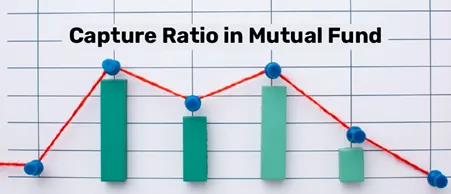Capture ratio in mutual fund: Definition, advantages and insights


Mutual fund analysis doesn't stop at assessment of returns or risk. Advanced measures are required to properly gauge the performance of a fund against its benchmark. The capture ratio in mutual fund analysis reveals how effectively a fund captures gains in rising markets versus how it captures losses during market downturns. Dividing the upside from the downside allows you to determine if a fund manager has the ability to profit from bullish markets and mitigate his losses when markets sag.
In this article, we will look at what is capture ratio, its upside-downside framework, and its usefulness in the mutual fund selection process.
- Table of contents
- Understanding capture ratio
- Defining a ‘good’ capture ratio
- Different types of capture ratios
- Upside and downside capture ratio
- Formula and steps for calculation
- Observations for capture ratio
- Using capture ratios in mutual fund analyses
- When reading capture ratios:
Understanding capture ratio
Capture ratio meaning: it’s a pair of metrics - up-market capture (often called upside capture) and down-market capture (downside capture) - that measure how a fund performs in bullish versus bearish conditions relative to a particular benchmark.
If a fund has an upside capture ratio of 120%, it means that, on average, when the benchmark goes up, the fund’s returns rise 20% more than the index’s gains. However, a downside capture ratio of, say, 80% tells that the fund reduces only 80% as much as the benchmark in bad market conditions.
Together, these two numbers show how closely the fund’s manager correlates with the market’s upward and downward movements.
Read Also: PB ratio: High vs low, which is better for investment?
Defining a ‘good’ capture ratio
A “good” ratio is context dependent. Generally, you’d like a higher upside capture ratio (>100%) - meaning the fund outperforms the benchmark when markets surge - and a lower downside capture ratio (<100%), signifying the fund loses less than the benchmark during sell-offs.
However, there is no capture ratio that works for all situations. Some stable funds might show a moderate upside ratio with a lower downside ratio, appealing to conservative investors. Aggressive funds might show bigger swings in both directions.
Different types of capture ratios
The different types of capture ratio depend on two metrics:
- Upside capture ratio: Sometimes called up-market capture, looking at gains in bull markets or positive months.
- Downside capture ratio: Also known as down-market capture, focusing on losses in bear markets or negative months.
Upside and downside capture ratio
What is the upside of capture ratio or up-market capture ratio? This metric compares how the fund performs during periods when the benchmark is trending upward. If, over certain time spans, the benchmark yields 10% gains, a 110% upside capture ratio suggests the fund generated an average 11% in those same intervals.
The ratio is typically aggregated across multiple up periods:
Meanwhile, the downside capture ratio addresses negative benchmark returns. If the index declines 8% in a period, and your fund’s average decline in those same periods is 6%, then the fund’s downside capture ratio is (6 ÷ 8) × 100 = 75%. A ratio below 100% means the fund experiences smaller losses relative to the benchmark. If it’s above 100%, the fund’s losses exceed the index’s, raising concerns about vulnerability in bear phases.
Formula and steps for calculation
Capture ratio usually breaks down into two formulas, one each for upside and downside.
For upside:
For downside:
Observations for capture ratio
- Time frame: Ratios might differ significantly if measured over a 6-month vs. a 5-year horizon. A short window could produce skewed impressions.
- Sector or style influence: A specialised sector fund might show strong upside capture but also big downside risk if the sector cycles strongly.
- Benchmarks: Ensure the index is relevant. A mid cap fund’s ratio computed against a large cap index might yield misleading insights.
- Stability: Frequent style shifts in a fund can hamper consistent capture ratio patterns.
Using capture ratios in mutual fund analyses
How to use capture Ratios for mutual funds analysis effectively:
- Compare similar funds: If two large cap funds have the same overall returns, but one shows an upside capture of 110% and a downside of 90%, it might indicate superior management of both bull and bear cycles.
- Supplement with return metrics: Capture ratio alone doesn’t reflect absolute returns. Confirm the fund’s actual annualised gains.
- Risk tolerance matching: Funds with high upside and moderate downside might suit more aggressive profiles. Conversely, investors wanting capital preservation look for moderate upside but notably low downside capture.
- Track over multiple cycles: A single period can be unrepresentative. Checking ratio consistency across different bull/bear phases can confirm reliability.
When reading capture ratios:
- Choppy market effects: In volatile markets, monthly swings can distort monthly-based calculations.
- Fund strategy: Some funds might intentionally hold more cash or shift assets drastically, impacting short-term captures.
- Expense ratios: If a fund’s approach is beneficial but overshadowed by high fees, net returns might lag. Confirm total cost structure.
Read Also: How is Sharpe ratio calculated?
Conclusion
The capture ratio in mutual fund analysis can be an invaluable metric, illuminating how effectively a manager capitalises on market upswings versus how much they shield you during downswings. Understanding what is capture ratio - along with the distinction between up-market capture and down-market capture - supports better comparisons among funds vying for your portfolio space. If a fund consistently scores well on both upside and downside capture, that indicates adept risk-adjusted performance. However, you still need to weigh expense ratios, manager tenure, and alignment with your personal goals. Ultimately, if you’re also exploring your mutual fund choices, factoring in capture ratios might refine the selection process, ensuring you pick a scheme that not only thrives in bullish spells but also proves resilient in adversity.
FAQs:
How do you calculate capture ratio?
You calculate an upside capture ratio by comparing the fund’s returns in the benchmark’s positive months with the benchmark’s returns, then expressing it as a percentage. A similar approach applies for the downside ratio, focusing on negative benchmark months.
How do you calculate upside capture ratio?
Sum the fund’s average return during each month the benchmark was positive, then sum the benchmark’s returns for those months. Divide the two (fund ÷ benchmark) and multiply by 100. That yields the up-market capture ratio.
What does an up-market capture ratio greater than 100 indicate?
It shows the fund outperforms the benchmark during market upswings. For instance, a ratio of 110% means when the index gains X%, the fund, on average, gains 10% more than X in those rising periods.
Why should investors consider both the up-market and down-market capture ratios?
Because seeing how a fund performs in bull runs alone ignores how it might behave in bear markets. A balanced appraisal requires for both sides: you want strong gains in rallies yet not unrestrained losses in downturns.
How does the up-market capture ratio differ from the down-market capture ratio?
The up-market capture ratio gauges a fund’s relative gains when the benchmark is positive, while the down-market capture ratio evaluates how the fund handles losses when the benchmark is negative. Both together illustrate the fund’s dual-phase performance profile.
Mutual Fund investments are subject to market risks, read all scheme related documents carefully.
This document should not be treated as endorsement of the views/opinions or as investment advice. This document should not be construed as a research report or a recommendation to buy or sell any security. This document is for information purpose only and should not be construed as a promise on minimum returns or safeguard of capital. This document alone is not sufficient and should not be used for the development or implementation of an investment strategy. The recipient should note and understand that the information provided above may not contain all the material aspects relevant for making an investment decision. Investors are advised to consult their own investment advisor before making any investment decision in light of their risk appetite, investment goals and horizon. This information is subject to change without any prior notice.
The content herein has been prepared on the basis of publicly available information believed to be reliable. However, Bajaj Finserv Asset Management Ltd. does not guarantee the accuracy of such information, assure its completeness or warrant such information will not be changed. The tax information (if any) in this article is based on prevailing laws at the time of publishing the article and is subject to change. Please consult a tax professional or refer to the latest regulations for up-to-date information.